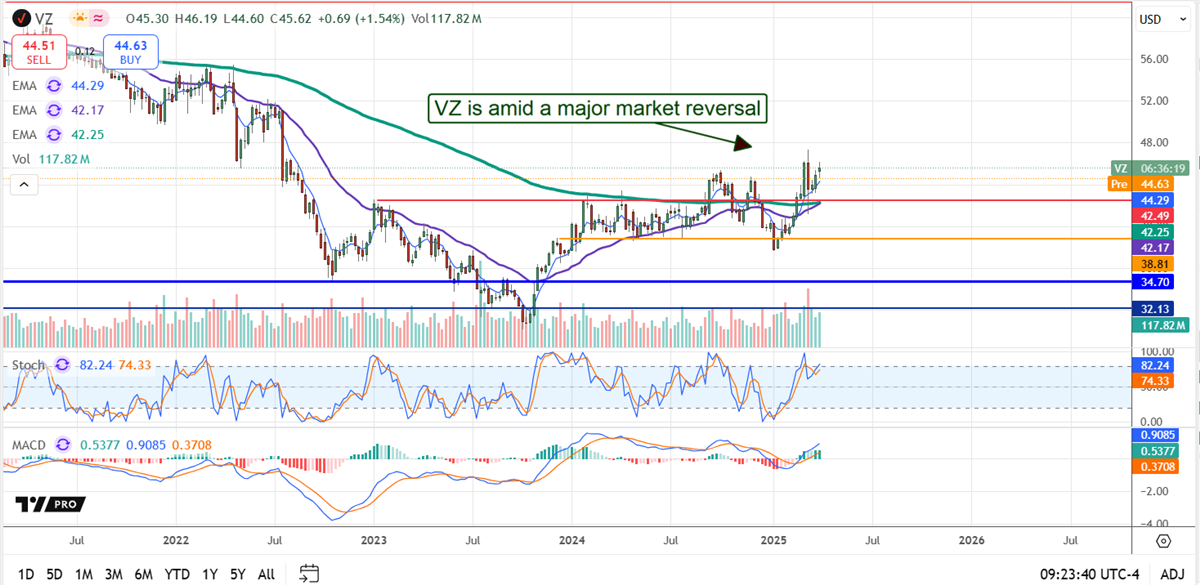Ticker Reports for April 7th
2 Defensive Sectors to Protect Your Portfolio During a Recession
As recession fears rise and the fear index plummets toward levels last seen during the March 2020 pandemic panic, U.S. and global equities are taking a significant hit. Investors are beginning to feel the pressure as trade tensions escalate, with China and the European Union, key U.S. trading partners, doubling down on retaliatory tariffs. With no trade resolution in sight, the market continues to spiral lower.
Technology stocks have been hit especially hard as investors aggressively rotate out of risk assets. Ahead of Monday’s open, futures are signaling further losses. The Technology Sector SPDR ETF (NYSEARCA: XLK) is now down 21.5% year-to-date and 25% off its 52-week high as of Friday’s close. Meanwhile, as of Friday's close, the S&P 500 has fallen nearly 18% from its recent peak.
With this level of volatility and uncertainty, many investors might wonder: Which sectors typically outperform during recessions and times of fear? While no corner of the market is entirely immune to sell-offs, history shows that two sectors, Consumer Staples and Utilities, tend to provide relative safety and stability during downturns.
Consumer Staples: A Classic Defensive Play
The Consumer Staples Select Sector SPDR ETF (NYSEARCA: XLP) is down just over 7% from its 52-week high as of Friday’s close, much less than the broader market. That relative strength reflects the sector’s defensive nature. It also offers a 2.6% dividend yield, adding an income cushion during volatile periods.
Consumer staples include everyday essentials like toothpaste, household cleaning products, food, and beverages. No matter how bad the economy gets, people still need to buy these goods. That steady demand benefits companies like Procter & Gamble, Coca-Cola, Walmart, and Johnson & Johnson, giving the sector a reliable edge over more cyclical industries like tech or discretionary retail.
Though the sector hasn’t been immune to the sell-off, its milder decline signals defensive positioning. That said, investors should proceed with caution. On Friday, XLP closed below its rising 200-day moving average and looks set to open lower on Monday. Watching top holdings such as Costco, Walmart, and Coca-Cola for signs of stabilization and relative strength could help investors identify when the sector begins to attract renewed interest as a haven.
Utilities: Stability and Dividends in Uncertain Times
The Utilities Select Sector SPDR ETF (NYSEARCA: XLU) has also shown notable resilience. Year-to-date, it is down just 1.5% and about 11% from its 52-week high, considerably less than the S&P 500’s drawdown. Like consumer staples, utilities benefit from their essential nature and reliable revenue streams, which help them weather economic storms better than most sectors.
The utilities sector includes companies that provide critical services like electricity, natural gas, water, and sewage systems. These services are needed regardless of economic conditions, making the sector a historically strong performer during downturns. XLU also offers an attractive 3.06% dividend yield, which can appeal to income-focused investors in turbulent markets.
However, the sector hasn't escaped the broader market pain. On Friday, XLU fell more than 5%, and based on futures, it looks set for another tough session on Monday. Many of its top holdings, including Southern Company, Duke Energy, and NextEra Energy, are trading near or below their 200-day SMAs. Investors may want to monitor these names closely to see if they begin to outperform relative to the market, signaling a shift toward defensiveness.
Positioning for Growth Through Stability
Consumer Staples and Utilities have historically been two go-to sectors, among others, for investors seeking stability during market turbulence and recessionary periods. While the current sell-off is intense and the geopolitical backdrop remains uncertain, these two sectors might offer a measure of safety, and possibly even opportunity, for long-term investors looking to weather the storm.
As always, watching for signs of relative strength and stabilization in top holdings can help confirm whether capital is rotating into these traditionally defensive sectors.
Warning: "DOGE Collapse" imminent
Elon Strikes Back
You may already sense that the tide is turning against Elon Musk and DOGE. Just this week, President Trump promised to buy a Tesla to help support Musk in the face of a boycott against his company. But according to one research group, with connections to the Pentagon and the U.S. government, Elon's preparing to strike back in a much bigger way in the days ahead.
Top 2 Stocks to Ride the AI Boom Without NVIDIA
There is one name synonymous with the artificial intelligence (AI) revolution in the computer and technology sector. NVIDIA Corp. (NASDAQ: NVDA) commands over 92% of the graphic processing unit (GPU) market, making it the leading company benefiting from the surge in AI infrastructure demand. Their AI chips are in such demand that their next-generation Blackwell GPUs are already sold out for the next 12 months. They are essential tools for cutting-edge AI, machine learning (ML) and high-performance computing (HPC) tasks often performed in data centers.
Why ASICs Could Outperform GPUs for Specialized AI Tasks
Competitors in the computer and technology sector, like Advanced Micro Devices Inc. (NASDAQ: AMD), can't make a dent in NVIDIA’s moat. However, two other rising stars in the AI boom are gaining ground, making application-specific integrated circuits (ASICs). These are AI chips custom-built to perform specific tasks like inference and training even more efficiently and at a lower cost than NVIDIA’s GPUs.
While NVIDIA’s GPUs power the foundation of AI, ASICs offer more specialized, efficient solutions. Here are two alternative stocks to buy to capture the next phase of the AI Gold Rush.
Broadcom: Bolstering AI Infrastructure With Networking and ASICs
Broadcom Inc. (NASDAQ: AVGO) specializes in high-performance networking solutions, offering the speed and bandwidth required to power modern AI data centers. Broadcom’s ethernet switches enable GPUs and chips to communicate with each other, especially during distributed training of large AI models and applications. Broadcom commands over a 50% market share of the ASICs industry.
Broadcom develops custom AI accelerators (XPUs), which are designed and optimized for specific tasks like training, inference and compute offloading. They also develop networking ASICs like the Trident and Tomahawk series that manage data traffic in AI data centers. They primarily develop ASICs for three major hyperscalers, including Alphabet Inc. (NASDAQ: GOOGL) tensor processing units (TPUs), Meta Platforms Inc. (NASDAQ: META) Meta-training-and-inference-accelerators (MTIAs), which are used to support generative AI services and ByteDance, the Chinese owner of TikTok.
Powering 77% FQ1 2025 YOY AI Revenue Growth
While its conventional semiconductor business still remains sluggish, its AI-centric revenues surged 77% in its FQ1 2025 earnings to $4.1 billion, well above its $3.8 billion forecast.
Gross margins were an incredible 79.1%, helping to grow total revenues by 24.7% year-over-year (YOY) to $14.92 billion, crushing consensus analyst estimates for $14.62 billion by $300 million.
The company is ratcheting up its R&D for its next-generation XPUs and Ethernet switches.
Broadcom also hinted at signing two more hyperscalers for XPUs, but it will take at least 1.5 years to develop.
Additionally, Broadcom raised its FQ2 revenue guidance to $14.90 billion vs $14.71 billion consensus estimates.
Marvell Technology: Growing ASICs Business with Amazon and Microsoft
Another key player in the ASIC market is Marvell Technology Inc. (NASDAQ: MRVL), focusing on data center interconnects (DCI). Its advanced Serializer-Deserializer (SerDes) technology enables the efficient movement of large data volumes within AI systems, helping overcome major data center bottlenecks. Though smaller than Broadcom, with less than one-sixth of its revenue, Marvell remains a critical player in the AI infrastructure buildout. However, they are gaining ground thanks to its close relationship with hyperscalers Amazon.com Inc. (NASDAQ: AMZN) developing their Trainium and Inferentia AI chips and, speculatively, Microsoft Co. (NASDAQ: MSFT) next-generation MAIA AI chip development.
Marvell's custom ASICs are optimized for training and inference (Trainium and Inferential ASICs) with low-power designs primarily for data center AI workloads. Its ARM-based system on a chip (SoC) subsystems support 14 nanometers (nm), 7nm, 5nm and 3nm processes. Marvell touts having developed over 2,500 ASICs in the past 25 years and being the first to roll out ASIC-as-a-service in 2020.
Growth Is Great, But Signs of Slowdown Alarm Investors
Marvell Technology reported FQ4 2025 earnings-per-share (EPS) of 60 cents, beating consensus estimates by a penny. Revenues rose 27.4% YOY, $1.82 billion vs $1.8 billion consensus estimates. GAAP gross margin was 50.5%. Data center revenues climbed 75% YOY, driven by the AI boom.
This is on top of the 54% YOY generated last year. Its custom ASIC revenue helped drive data center revenues to a record $1.37 billion. However, its Consumer segment revenues fell 38% YOY to $88.7 million, driven by a weak gaming market.
The disappointment came from its lackluster guidance for FQ1 2026. While they did beat consensus analyst estimates, they didn't beat them by much, as analysts were expecting a much larger upside beat.
Marvell expects EPS between 56 cents and 66 cents, with a midpoint of 61 cents vs. 60 cents consensus estimates. Revenues are expected to be between $1.78 billion and $1.97 billion, with a midpoint of $1.875 billion versus $1.87 billion consensus estimates.
Get Your Bank Account "Fed Invasion" Ready with THESE 4 Simple Steps
Starting as soon as a few months from now, the United States government will make a sweeping change to bank accounts nationwide.
It will give them unprecedented powers to control your bank account.
4 Dividend Growth Stocks the Trade Tariffs Can't Touch
Tariffs are in the news and will impact the broad stock market in 2025 and potentially longer, but not all stocks are in the same precarious predicament.
While many companies manufacture and/or sell their products and services overseas, not all do, and some companies are actually positioned to benefit from the tariff impact. Companies with strong domestic operations and limited reliance on foreign markets may emerge as winners amid the 2025 tariff shake-up.
Here's a closer look at four stocks with limited international exposure or that are positioned to benefit from tariff-related disruptions this year: The J.M. Smucker Company (NYSE: SJM), Verizon (NYSE: VZ), Altria (NYSE: MO), and Columbia Banking System (NASDAQ: COLB).
J.M. Smucker: A Domestic Player With Market Share Upside
The U.S. jam and jelly industry isn’t phenomenally large, and The J.M. Smucker Company commands a tiny 1.2% of it. However, the company is in a position to gain that share in 2025.
Nearly 25% of all U.S. jam and jelly products are imported, leaving a significant gap that lower-priced, domestically sourced products can fill.
If J.M. Smucker can capture even 1% of the gap, it would be worth about 3% in annualized revenue growth relative to the F2025 forecasts reported by MarketBeat. Other categories in which SJM competes are similarly positioned.
The SJM dividend will be substantial in 2025. The stock price is down due to repositioning efforts and an analyst price target reset that put the dividend above 3.6%. The payout is safe at roughly 50% of the earnings forecast, and growth is in the picture.
The company is expected to continue growing in F2026, albeit more slowly, sufficient to sustain the distribution increase trend. That includes 24 years of annual increase and a 5% distribution CAGR over the last five years.
Analysts rate this consumer staple stock as a Hold and see it advancing about 5% from the critical resistance target.

Verizon: A High-Yield, Service-Based Hedge Against Tariffs
Verizon’s stock price has been ratcheting higher for the last year as improving business metrics led to improving balance sheet health and shareholder value.
The story in 2025 is that its internationally operating business is relatively insulated from tariffs because (at least for now) there aren’t any tariffs on services. Even then, it’s questionable if Verizon’s locally operated businesses will be impacted.
Its biggest hurdle will be FX translation, and that’s already a headwind impacting the industry. Until then, the stock yields nearly 6% in early Q2, trading at only 10x earnings, with bullish price action and indications of higher prices to come.
Verizon’s analyst sentiment trend is bullish. Over the last year, the number of analysts covering VZ stock has been relatively steady. Still, the consensus rating has firmed due to upgrades and improved from Hold to Moderate Buy, including two Strong Buy ratings.
The price target assumes fair value near the April 4th price point but is edging higher in 2025. Revisions lead to the high-end range or nearly 25% of the upside.

Altria: Domestic Supply Chain Protects Margins
Altria is a unique business with a global footprint that derives nearly 100% of its revenue from U.S.-grown tobacco.
Its customers may face tariffs on imports, but Altria is virtually immune, leaving its margin outlook intact with the potential to increase. This is critical because Altria is a cash flow and capital-returning machine with a healthy 7% dividend yield that costs a mere 10x earnings.
Altria also buys back significant quantities of shares, reducing the count by more than 4% in 2025, and announced a new $1 billion authorization for 2025, which has the market in rally mode.

Columbia Banking System: Tariff-Proof with Growth Potential
Columbia Banking System is the holding company for Umpqua Bank, which operates in the Pacific Northwest.
It is another low-cost, high-yield investment that yielded more than 6% in early 2025.
The narrative in 2025 is that this company will revert to growth and produce sufficient cash flow to sustain its dividend and balance sheet.
Analysts rate COLB a Hold but have a growing conviction that its stock price will increase by at least 45%.










